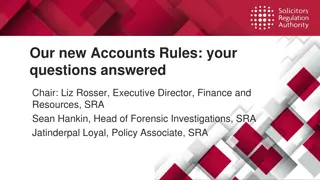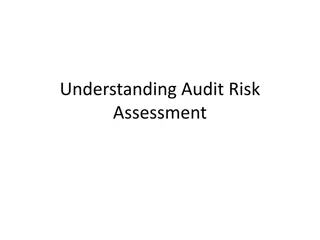Mobility Risk Assessment Process in Client Care
The Mobility Risk Assessment Process in Client Care involves conducting initial assessments to determine baseline mobility, identifying risks, selecting appropriate moving techniques, and effectively communicating and evaluating risks throughout care. The assessment considers communication status, potential aggression, and existing mobility devices. Strategies for managing communication barriers and decreasing consciousness levels are integral parts of the process.
- Mobility Risk Assessment
- Client Care
- Assessment Process
- Communication Management
- Risk Identification
Download Presentation

Please find below an Image/Link to download the presentation.
The content on the website is provided AS IS for your information and personal use only. It may not be sold, licensed, or shared on other websites without obtaining consent from the author. Download presentation by click this link. If you encounter any issues during the download, it is possible that the publisher has removed the file from their server.
E N D
Presentation Transcript
Client Mobility Risk Assessment SASWH acknowledges the Saskatchewan Health Authority-Saskatoon for the concept to develop this PowerPoint to further support TLR Client Mobility Risk Assessment (Oct/20)
Material Required Participant Handbook Mobility Record Quick Reference Card Bed or Chair Transfer Belt
Learning outcomes: identify risks in the client s ability to mobilize Initial client mobility risk assessment (provides baseline) documenting the assessment eliminate or manage risks selecting appropriate moving technique evaluate and communicate In the Moment risk assessment
Initial Client Mobility Risk Assessment conducted when the client is assessed for their care plan to determine their baseline mobility completed face to face with the client a focused approach that requires listening, observing and documenting conducted prior to moving the client documented on a TLR Mobility Record (or an employer s comparable form) and becomes part of the client s chart
Conducting the Assessment the worker considers their approach and attitude introduces themselves by providing name and job title worker explains the assessment process and why it is necessary worker considers the potential for assaultive, aggressive or violent behaviour considers any existing mobility devices the client may have
Part A Verbal, Written and Observation
Areas of risk: Communication Status How do we communicate? Is language a barrier? Will vision and hearing impact the move?
Managing risks of Communication Status How do we communicate? Use of sign language, interpreter or devices For non verbal may require other methods of communication e.g. pen and paper, hand gestures, nods If there is a decreased level of consciousness, move may need to be delayed. Is language a barrier? May need interpreter/ family member Use of cue cards
Managing risks of Communication Status Will vision and hearing impact the move? Ensure hearing aides are in the ears and functioning Glasses are on and clean
Areas of risk: Cognitive Status Is short-term memory part of the diagnosis? Does client exhibit appropriate judgement? Is client s ability to make decisions compromised? Alertness? (May depend on many factors)
Managing Risks of Cognitive Status Is short-term memory part of the diagnosis? Do they exhibit appropriate judgement? Is their ability to make decisions compromised? Give short, clear, step by step instructions to decrease frustration or confusion Allow client time to process the instructions, before moving to next task Gauge clients response to ensure the appropriate decision is being made Move may need to be delayed if client exhibits poor judgement
Managing Risks of Cognitive Status Alertness? (May depend on many factors) Diagnosis Time of day (e.g. sundowning) Side effects from medications Move may need to be delayed if there is a decreased level of consciousness
Areas of risk: Emotional & Behavioural Status Will their mood affect a safe move? Does the client display stable moods? Does the client display predictable/cooperative behaviours? Is there history of mood variances, aggressive, or abusive behaviour?
Managing Risks of Emotional & Behavioural Status Will their mood affect a safe move? Check for any client history of mood variances as certain diagnosis can alter a clients mood Mood can vary throughout the day (e.g. sundowning) Delay move if client is uncooperative
Managing Risks of Emotional & Behavioural Status Does the client display stable moods? Does the client display predictable/cooperative behaviours? Is there history of mood variances, aggressive, or abusive behaviour? Delay move in order to allow a cooling down period Involve a worker or family member who has an approach that the client may respond favorably to Assess the reason for the behavior e.g. pain, fatigue, depression
Areas of risk: Medical Status Are there medical conditions, diagnosis or skin integrity concerns? Is body awareness/weight distribution an area of concern? Will an attachment/appliance affect a safe move? Will pain/fatigue affect a safe move? What medications are being taken that may interfere with a safe move? Are any mobility assistive devices used by the client?
Managing Risks of Medical Status Are there medical conditions, diagnosis or skin integrity issues? Are there body awareness or weight distribution issues? The level of assistance may need to be increased Consider a specialized client mobility risk assessment
Managing Risks of Medical Status Will an attachment/appliance affect a safe move? Ensure training needed for proper application of devices is provided Consider a specialized client mobility risk assessment Will pain/fatigue affect a safe move? Clients with stiffness from arthritis may need a slower pace Daily activities that tire clients may require additional workers to assist with the moving task after activities Timing of specific medications may need to be considered
Managing Risks of Medical Status What medications are being taken? Understanding potential side affects Additional workers may be required for assistance Move may need to be delayed Are mobility assistive devices used by client? Ensure device is used during Part B testing
Part B Testing and Observation
Physical and Functional Status Pre-mobilization testing Upper limb tests Lower limb tests Core tests Mobilization testing Sitting tests Standing tests (transfer belt required) Walking tests (transfer belt required)
Physical and functional status: Pre-mobilization testing Requires hands on approach by the worker completing the risk assessment The client can be assessed either in a seated or supine position Mobilization testing Requires hands on approach by the worker completing the risk assessment and use of a transfer belt The client requires a degree of mobility A second worker must be immediately available
Pre-mobilization testing Upper limb tests: Does the client have the ability to grip, push and pull your hand in a handshake approach? On their right? On their left? What information will you gather from this test? Ability to comprehend and cooperate Pain Range of motion in each shoulder Ability to grip with each hand Weight bearing ability through each shoulder Strength and control of each upper limb
Lower limb tests: Does the client have the ability to lift one leg at a time off the bed or seated surface, and bend and straighten the knee? Does the client have the ability to move their foot up and down at the ankle? Tests needs to be conducted on both legs What information will you gather from this test? Ability to comprehend and cooperate Pain Range of motion for each hip, knee and ankle Lower limb strength and control for each hip, knee and ankle Core strength for stabilization Weight bearing ability through each lower limb
Core testing: In supine: Can the client bridge? Can the client roll from side to side? OR In sitting: Raise their buttocks off a seated surface? Can they hip walk forward? What information will you gather from this test? Ability to comprehend and cooperate Pain Balance Strength Possible hypotension (dizziness) Endurance Trunk control and strength
Mobilization testing Sitting Tests: Does the client have the ability to get themselves into a seated position? Does the client have the ability to remain seated, with feet on floor, for 20 seconds? Can the client right themselves if gently tipped in all four directions? If client has a weaker side do not tip in that direction! What information will you gather from this test? Ability to comprehend and cooperate Pain Balance Strength Possible hypotension (dizziness) Endurance Trunk control and strength
Standing Tests with Transfer Belt: Does the client have the ability to: - position themselves in preparation for standing ? - remain standing for 20 seconds? - raise one arm at a time to front and side and remain steady? What information will you gather from this test? Ability to comprehend and cooperate Pain Balance Strength Possible hypotension (dizziness) Endurance Use their arms functionally Leg strength and control Trunk and pelvic strength and control Capacity to bear weight
Walking tests: Does the client have the ability to: - shift weight from one foot to the other? - walk (or shuffle) on the spot? - take 3 steps forward and 3 steps back? What information will you gather from this test? Ability to comprehend and cooperate Pain Trunk control Strength Possible hypotension (dizziness) Endurance Dynamic balance Ability to weight transfer Strength Safely walk on the spot Weight bear while walking (or shuffling) Coordinate functional movement
In the Moment Risk Assessment This is a mental checklist to aide in identifying risks on a regular basis Changes that alert the worker could include: facial asymmetry paleness and cyanosis shortness of breath slurring or incoherent speech not sitting well in a chair (slumping or sliding out) Remember to incorporate self, environment and equipment assessments at the time of the move
In the Moment Risk Assessment Workers may need to increase the level of assistance at the time of the move Workers CAN NOT decrease the level of assistance without a documented re-assessment completed Any changes to the level of assistance must be communicated and documented After two separate documented changes, a re-assessment is completed
Problem-Solving Risk Factors: Select another safe approach at the time Seek assistance to problem solve Identify and schedule tasks for when working alone and team approach is safest. Document and forward concerns to supervisor Forward concerns to OH&S if not resolved at supervisor level























